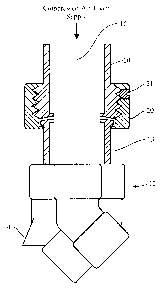Some of the information on this Web page has been provided by external sources. The Government of Canada is not responsible for the accuracy, reliability or currency of the information supplied by external sources. Users wishing to rely upon this information should consult directly with the source of the information. Content provided by external sources is not subject to official languages, privacy and accessibility requirements.
Any discrepancies in the text and image of the Claims and Abstract are due to differing posting times. Text of the Claims and Abstract are posted:
| (12) Patent: | (11) CA 2131109 |
|---|---|
| (54) English Title: | FOAM NOZZLE |
| (54) French Title: | LANCE A MOUSSE |
| Status: | Term Expired - Post Grant Beyond Limit |
| (51) International Patent Classification (IPC): |
|
|---|---|
| (72) Inventors : |
|
| (73) Owners : |
|
| (71) Applicants : |
|
| (74) Agent: | |
| (74) Associate agent: | |
| (45) Issued: | 2002-11-12 |
| (22) Filed Date: | 1994-08-30 |
| (41) Open to Public Inspection: | 1996-03-01 |
| Examination requested: | 1999-08-11 |
| Availability of licence: | N/A |
| Dedicated to the Public: | N/A |
| (25) Language of filing: | English |
| Patent Cooperation Treaty (PCT): | No |
|---|
| (30) Application Priority Data: | None |
|---|
A compressed-air foam (CAF) nozzle has a stationary barrel and a distributor assembly with typically three outlets which are angled and skewed against each other. The distributor assembly is rotatably connected to the barrel and rotates when a stream of fluid is passed through the nozzle. The nozzle enables the delivery of a CAF stream at a relatively wide delivery angle without significantly collapsing the bubble structure of the foam.
Lance à mousse à air comprimé (MAC) comprenant un baril stationnaire et un ensemble distributeur avec typiquement trois sorties qui sont coudées et les unes contre les autres. L'ensemble distributeur est raccordé avec faculté de rotation au baril et tourne lorsqu'un courant de fluide passe à travers la lance. La lance active la fourniture d'un courant de MAC selon un angle de fourniture relativement large sans affaisser significativement la structure en bulles de la mousse.
Note: Claims are shown in the official language in which they were submitted.
Note: Descriptions are shown in the official language in which they were submitted.

2024-08-01:As part of the Next Generation Patents (NGP) transition, the Canadian Patents Database (CPD) now contains a more detailed Event History, which replicates the Event Log of our new back-office solution.
Please note that "Inactive:" events refers to events no longer in use in our new back-office solution.
For a clearer understanding of the status of the application/patent presented on this page, the site Disclaimer , as well as the definitions for Patent , Event History , Maintenance Fee and Payment History should be consulted.
| Description | Date |
|---|---|
| Inactive: Expired (new Act pat) | 2014-08-30 |
| Maintenance Request Received | 2013-06-04 |
| Inactive: Cover page published | 2012-11-26 |
| Inactive: Acknowledgment of s.8 Act correction | 2012-11-20 |
| Inactive: S.8 Act correction requested | 2009-01-20 |
| Inactive: Late MF processed | 2008-10-22 |
| Letter Sent | 2008-09-02 |
| Inactive: IPC from MCD | 2006-03-11 |
| Inactive: IPC from MCD | 2006-03-11 |
| Inactive: Late MF processed | 2005-10-28 |
| Letter Sent | 2005-08-30 |
| Grant by Issuance | 2002-11-12 |
| Inactive: Cover page published | 2002-11-11 |
| Pre-grant | 2002-07-08 |
| Inactive: Final fee received | 2002-07-08 |
| Notice of Allowance is Issued | 2002-02-11 |
| Letter Sent | 2002-02-11 |
| Notice of Allowance is Issued | 2002-02-11 |
| Inactive: Approved for allowance (AFA) | 2002-01-22 |
| Amendment Received - Voluntary Amendment | 2002-01-15 |
| Amendment Received - Voluntary Amendment | 2001-11-07 |
| Inactive: Office letter | 2001-09-19 |
| Inactive: Office letter | 2001-09-19 |
| Revocation of Agent Requirements Determined Compliant | 2001-09-19 |
| Revocation of Agent Request | 2001-07-30 |
| Inactive: S.30(2) Rules - Examiner requisition | 2001-07-23 |
| Letter Sent | 2000-10-11 |
| Reinstatement Requirements Deemed Compliant for All Abandonment Reasons | 2000-09-29 |
| Deemed Abandoned - Failure to Respond to Maintenance Fee Notice | 2000-08-30 |
| Amendment Received - Voluntary Amendment | 1999-12-10 |
| Inactive: Correspondence - Prosecution | 1999-09-21 |
| Inactive: Status info is complete as of Log entry date | 1999-08-31 |
| Letter Sent | 1999-08-31 |
| Inactive: Application prosecuted on TS as of Log entry date | 1999-08-31 |
| Request for Examination Requirements Determined Compliant | 1999-08-11 |
| All Requirements for Examination Determined Compliant | 1999-08-11 |
| Letter Sent | 1998-10-02 |
| Reinstatement Requirements Deemed Compliant for All Abandonment Reasons | 1998-09-24 |
| Deemed Abandoned - Failure to Respond to Maintenance Fee Notice | 1998-08-31 |
| Application Published (Open to Public Inspection) | 1996-03-01 |
| Abandonment Date | Reason | Reinstatement Date |
|---|---|---|
| 2000-08-30 | ||
| 1998-08-31 |
The last payment was received on 2002-07-25
Note : If the full payment has not been received on or before the date indicated, a further fee may be required which may be one of the following
Please refer to the CIPO Patent Fees web page to see all current fee amounts.
Note: Records showing the ownership history in alphabetical order.
| Current Owners on Record |
|---|
| NATIONAL RESEARCH COUNCIL OF CANADA |
| Past Owners on Record |
|---|
| GEORGE P. CRAMPTON |